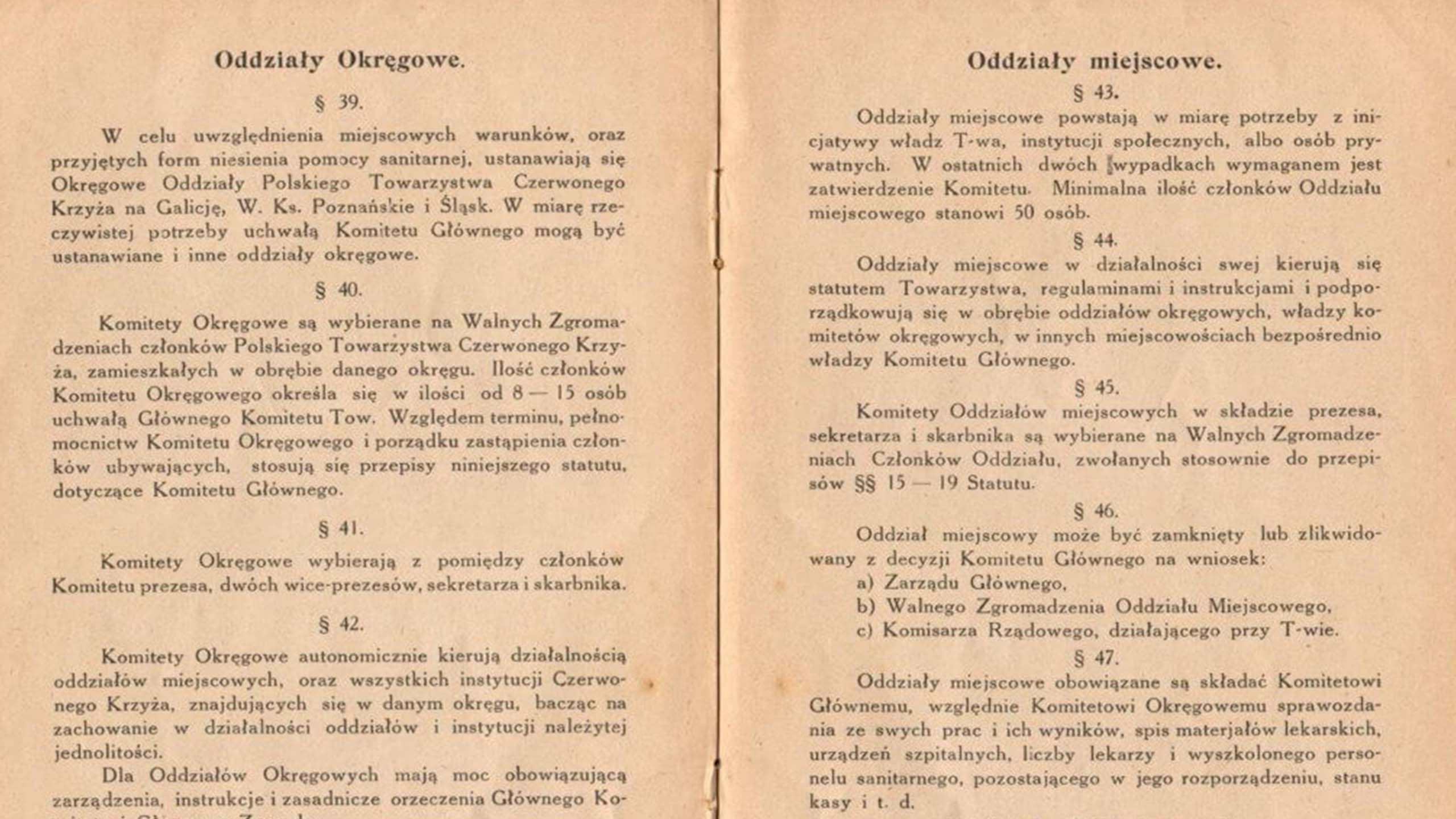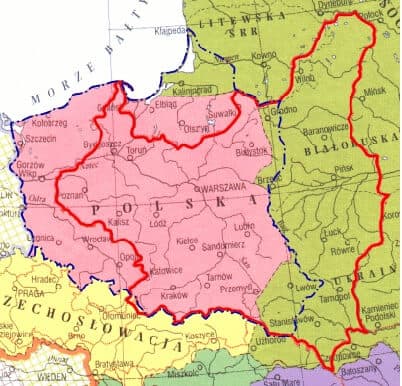At the beginning of 1919, within the structures of the newly established Polish Red Cross Society, 3 District Branches of PTCK were created: for Galicia, the Grand Duchy of Posen, and Silesia.

These branches are therefore the oldest organizational units of the Red Cross. The establishment of the first branches was recorded in the Statute of 1919 in paragraph 39.
As of August 1, 1919, the organizational structure changed, and there were already 4 District Committees: Lesser Poland, Greater Poland, South-East, and Polesie-Miński. Our organization as a whole will celebrate its 100th anniversary, however, the history and period of operation of each regional branch varies.
After Poland regained independence in 1918, borders were partially based on the borders of the Commonwealth of Both Nations before the partitions. In many places, territories were, however, disputed (including Silesia, Warmia, and Masuria). Their affiliation with Poland was largely determined by plebiscites and, in some cases, armed struggle (e.g. Greater Poland Uprising). Ultimately, the borders of the Second Polish Republic were established in 1922. Since then, until the outbreak of World War II, only a few minor changes occurred (including the occupation of Zaolzie in 1939). Within the boundaries of Poland, after regaining independence, there were 10 of today's 16 district branches (Kraków, Rzeszów, Katowice, Lublin, Łódź, Kielce, Warsaw, Poznań, Bydgoszcz, Białystok). Since the beginning of the Polish Red Cross Society, branches have operated in Lviv, Luck, and since 1925 also in Vilnius.
After World War II, new borders were established, based on the territory of Poland of the first Piasts. As a result of these changes (imposed by the Soviet Union), Poland lost territories in the eastern borderlands (the areas of present-day Belarus and western Ukraine) and gained West Pomerania, Silesia, and the vicinity of Zielona Góra. The western border was mostly established along the Oder River. The Polish Red Cross included branches in Szczecin, Zielona Góra, Wrocław, Opole, Olsztyn, and Gdańsk. Lviv, Luck, and Vilnius were located in the territory of the Soviet Union.

Mapa za https://www.geocaching.com/
Facts about the Polish Red Cross
Only after the fourth request to the International Red Cross was the Polish Red Cross recognized on the international stage.
The beginnings of blood donation in the Red Cross date back to 1935, which took place 83 years ago.
If the borders of Poland had not been changed after World War II, the 100th anniversary of the Polish Red Cross (PCK) would have been celebrated with the Lviv, Volhynian, and Wilno branches, which are still active today but under the structures of different state associations.
The employees of the Polish Red Cross carried out the exhumation of Polish officers murdered in the Katyn Forest while also being responsible for creating the official Katyn Lists
The Red Cross movement and its foundations were the source for the establishment of sanitary services for wounded soldiers under the names Polish White Cross and Polish Green Cross.
Over the years, the rules for statutory financing of the PCK's activities have changed, as has our role and position within the state.
The PCK enjoyed immense public trust during the Second Polish Republic, and the most important figures in the state always spoke about our organization with the utmost respect.
To this day, in Tarnów, Małopolska, there is a nearly 100-year tradition of parades through the city organized on the occasion of the Polish Red Cross Week.
On February 8, 2018, it was 50 years since the establishment of the badge of the Honorable Blood Donor
On February 8, 2018, it marked 50 years since the establishment of the badge of the Meritorious Honorary Blood Donor
PCK never accepted any gratifications and did not support the Nazi authorities, thereby exposing itself to severe consequences.
The Polish Red Cross was the initiator of healthcare in rural areas during the interwar period and the establishment of the first village health centers.
PCK was involved in the construction of the Marshal Piłsudski Mound in Sowińca in Krakow in 1936
At the beginning of 1919, within the structures of the newly established Polish Red Cross Society, 3 District Branches of the PTCK were created: for Galicia, the Grand Duchy of Posen, and Silesia.
During its 100-year activity, the Polish Red Cross, the International Committee of the Red Cross, honored 102 Polish nurses associated with our organization with the Florence Nightingale Medal.
The Polish Red Cross was the organizer of parachuting courses
Did two Polish doctors working at the Red Cross hospital during World War II save more lives than Oskar Schindler?
There existed simultaneously the Polish Red Cross and the Polish White Cross, whose president was Helena Paderewska.
There was a time in the history of PCK when, legally, two or even three Main Boards of PCK operated simultaneously.
Help us endlessly
Thanks to the kindness and support of our Donors, we can help children, seniors, support medical rescuers, promote the idea of blood donation, and implement many other projects that save lives in times of conflict or humanitarian crises. Every donation and every form of support is significant because the Polish Red Cross connects those in need with those who want to provide help. Let’s help together!
See also
During its 100-year operation, the Polish Red Cross was awarded the Florence Nightingale Medal by the International Committee of the Red Cross to 102 Polish nurses associated with our organization.
The Florence Nightingale Medal was established by the ICRC and awarded on the hundredth anniversary of Florence Nightingale's birth on May 12, 1920. The first Polish nurse to be awarded this medal was Countess Maria Tarnowska in 1923.
08. PCK was involved in the construction of the Marshal Piłsudski Mound in Sowińce, Kraków in 1936.
In 1934, the Legionnaires' Association was founded in Kraków and took the initiative to create a commemorative mound, which serves as a monument to the struggles for Independence. At the head of the Committee for the Construction of the Mound, established in Warsaw, was Walery Sławek.
You are currently viewing a page filtered by content from the department. Cała PolskaIf you want to view content from Cała Polskaclick the button